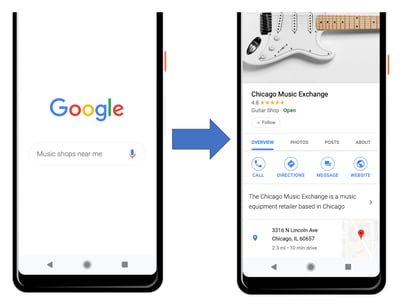 With the tremendous rise of voice assistants from the likes of Amazon, Google, and Apple, the percentage of search traffic coming from voice is dramatically increasing. This presents challenges for those who want to get found in voice search because of the importance of being listed as the first result.
With the tremendous rise of voice assistants from the likes of Amazon, Google, and Apple, the percentage of search traffic coming from voice is dramatically increasing. This presents challenges for those who want to get found in voice search because of the importance of being listed as the first result.
People are increasingly using the voice-enabled features of their smartphones to ask questions. They’re also installing voice assistants in their homes and cars. TechCrunch estimates that a quarter of U.S. households now have at least one voice-assisted smart speaker.
When people search using a computer keyboard or smartphone keypad, they typically type out a few words, like “Mexican restaurants in Boston.” There are likely to be ten or so results on the first page, and consumers will likely scan at least the first few results. Therefore, if you run a Mexican restaurant in Boston, holding the number two or three position in the search results is likely to greatly benefit your business.
It’s very different when people search through a voice assistant. Typically, the search is phrased as a question, using a complete sentence. Such searches are likely to be much more specific (long tail).
For example, a voice search might ask, “What’s the best Mexican restaurant nearby that’s open now?”
What comes back via the voice assistant is one result. If you aren’t in the number one position for that search, you get zero people learning about your restaurant from voice assistants for that search term.
This relatively new type of search situation means you need to try to understand all of the different ways people are likely to speak when asking about a topic related to your business. Create content accordingly.
A blog can be a great way to generate some of this long-tail content. Use headlines for your posts that correspond to how people might search by voice.
Another strategy is to create a detailed Frequently Asked Questions page. Structure your FAQs around what people might ask a voice assistant.
For example, the Boston Mexican restaurant might create questions and answers about Covid-19 precautions in place, takeout or curbside pickup options, wait times on a typical day, parking nearby, public transportation options, reservation availability, if alcohol is served, whether children are welcome, and so on.
This could mean that the Mexican restaurant could have dozens, or even hundreds of long tail search terms identified and made available to the voice search engines.
The importance of Google local
 If you run a local business, make sure you “claim” your Google Business profile, and ensure that the content is up to date.
If you run a local business, make sure you “claim” your Google Business profile, and ensure that the content is up to date.
This Google local listing appears on the right-hand side of the search results (or at the top on mobile!) when somebody enters your business name or closely associated keywords.
Your Google Business profile is also an important content source for voice assistants.
This profile is where Google picks up details like your business hours, address, and telephone number. This result also features reviews, so encourage your customers to leave positive reviews on Google. This will help when people use words like “best” in their voice search.
But it's not just local businesses. Every organization should be considering the implications of voice search.

David Meerman Scott
David Meerman Scott is a business growth strategist, advisor to emerging companies, and international bestselling author of a dozen books including Fanocracy and The New Rules of Marketing & PR. His books are published in 30 languages from Arabic to Vietnamese and have sold nearly a million copies.

 With the tremendous rise of voice assistants from the likes of Amazon, Google, and Apple, the percentage of search traffic coming from voice is dramatically increasing. This presents challenges for those who want to get found in voice search because of the importance of being listed as the first result.
With the tremendous rise of voice assistants from the likes of Amazon, Google, and Apple, the percentage of search traffic coming from voice is dramatically increasing. This presents challenges for those who want to get found in voice search because of the importance of being listed as the first result. If you run a local business, make sure you “claim” your
If you run a local business, make sure you “claim” your 







